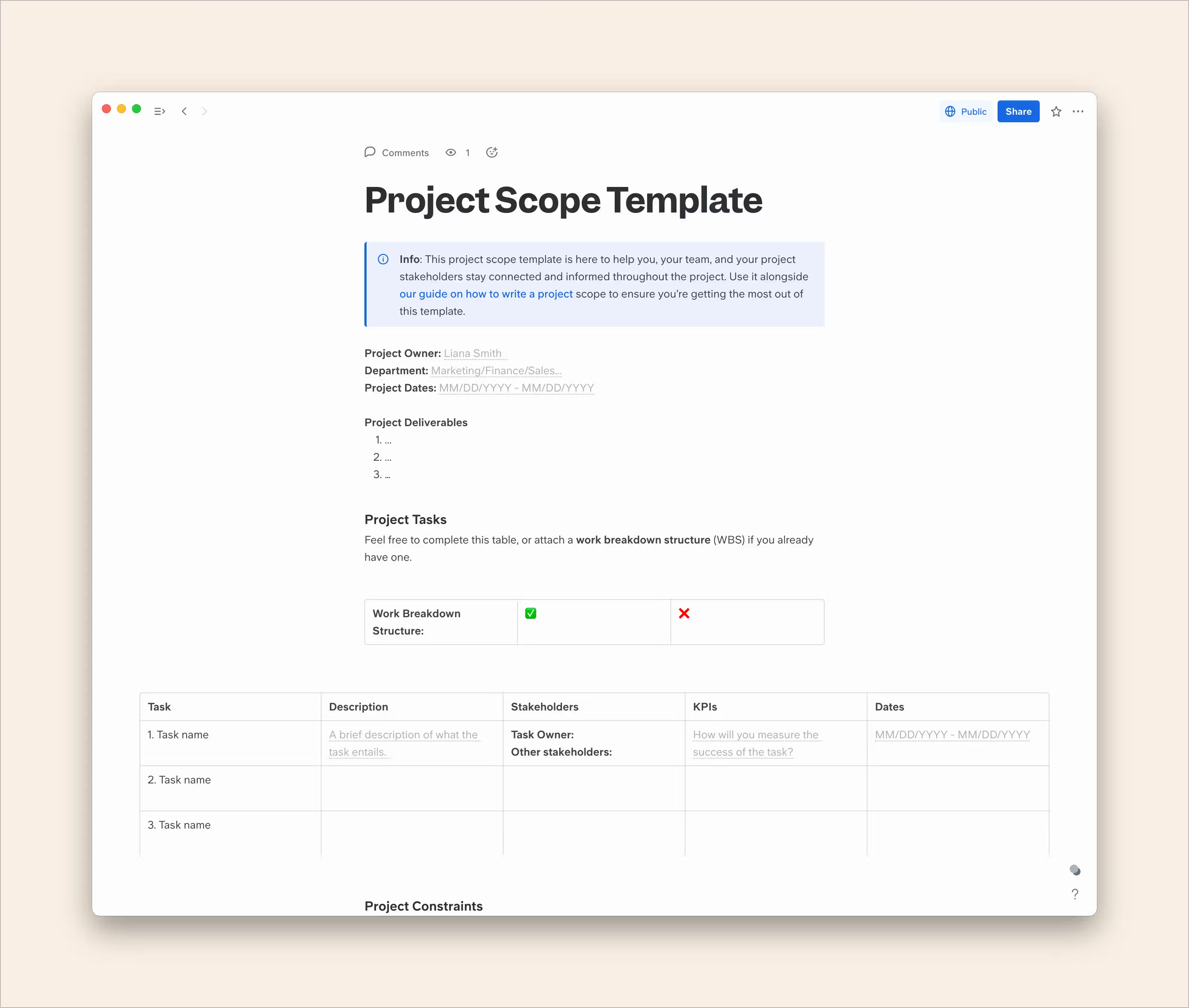Project scope and project scope management are essential things for any project manager to understand and look after. It's one of those terms you'll hear a lot within the role, yet you'll be surprised how few truly understand what it means.
In this article, we'll dive into everything you need to know about project scope and its life cycle, how to manage it, as well as how to write a project scope that's equal parts effective and understandable.
By the end of the article, you'll be able to walk away with an understanding and knowledge of scope definition and its purpose. Oh, and of course, we'll be leaving you with a free project scope template to make your work that much easier when building the scope of your project.

What is Project Scope?
Project Scope is at the heart of project management and helps determine a successful project. In short, a project scope documents everything needed for a project to get it done. The full scope of the project includes the project's deliverables, goals, processes, resources, costs, stakeholders, and deadlines. It involves everything that is "in scope" of the project and aligns everyone before a project begins.
💡 The scope of a project is not to be confused with a product scope.
What are the benefits of writing a project scope?
The product project management body of knowledge (pmbok) includes a heap of benefits to a scope management plan, but here are a few of our favorites.
🔭 Team alignment: A project scope aligns all of your project team members at the beginning, middle, and end of your project. It ensures everyone is on the same page with what's going on and everyone's' responsibilities.
🔭 Project planning and management efficiency: A project scope is a project manager's dream reference point. It helps to plan the entire project end-to-end and manage the efficiency of a project manager's workflow.
🔭 Aids other project processes: A project statement will be a reference document for other project processes. Things like project plans, project progress reports, project, supplemental project proposals, your project scope can support all of them.
🔭 A constant reference point: Your project scope will be a reference point for project managers, the project team, and key stakeholders or leadership. It's an internal document that everyone can use and rely on as the sole point of truth.
🔭Avoids scope creep: A project manager's worst nightmare, but certainly not uncommon. Scope creep is when the boundaries of your scope of work is pushed for whatever reasons, but with limited recourses.
For example, scope creep may occur when leadership wants a project completed in a shorter deadline but does not provide extra human resources to help a project manager meet a new deadline. A scope creep may also include building out a new product feature when you're halfway through the initial product build. Again, you will be expected to do this without extra resources, be it people, tech, or time.
Your project scope sets sturdy boundaries for where your project ends and defines those items that are "out of scope."
🔭 Manages expectations: When we say a project scope helps to manage expectations, your mind probably jumps straight to leadership, so they don't feel misled or expect more than what your project's end goals deliver. However, expectations don't stop there. They also manage your team's expectations and any external stakeholders you're working with. It helps everyone manage their time and other projects better. Another great way to exceed expectations is by using a marketing plan template alongside your Project Scope.

How to write a project scope in six steps
Also known as a project scope statement, writing a project scope is an essential skill for any project manager. As well as providing a free project scope statement template at the end of this article, use this checklist as a reference point for every project scope you need to write in the future.
Step 1: Onboard the project
If you're creating a project scope statement, it's because the project is already approved. However, this doesn't necessarily mean you were the one to submit the project proposal or the one to create the project proposal template; you may not have too much context around why the project idea was submitted or approved in the first place.
Not to worry, now's the time for you to get to grips with the context behind your project. If you have a company knowledge base or company wiki, then jump over to it and take a look at all of the digital documents already created about this project. Look at the proposal, and investigate with stakeholders to understand the project and its goals fully.
Step 2: Define project essentials
Once you've fully understood the project, it's time to introduce it, in short, to the rest of your team that will be using your project scope statement. You need to cover a few areas before you explain the details of what the project scope includes.
▶️ Project objectives
First up is the project's objectives. What is the tangible and measurable project goal in an ideal situation? There may be multiple goals for the project. Include them all here. The project's goals may not necessarily be a final product. They could be a solution to a problem or a much-needed enhancement to a stale process—be open to multiple goals.
▶️ KPIs & project deliverables
Secondly, you'll want to map out all of your KPIs and SMART goals that will help you get there. What do you need to be doing and when? Break your mountain down into a collection of sprints.
▶️Statement of Work
This defines the project's specific activities, project requirements, and what needs to be done to hit your goals. Look at it as the list of micro-projects to achieve the larger goals of the project. This work breakdown structure (wbs) will be essential to all project stakeholders throughout.

Step 3: List stakeholders and their boundaries
The chances are, your project will have a selection of stakeholders to play a part in the project's success. List these stakeholders, as well as what they need to do.
▶️ Approvers
Your approvers are your members of leadership, or management, that have ultimate sign off between project phases, budget approvals, and more. These people need to be aware of their responsibilities, and when needed, so they can prepare their calendars accordingly and don't become bottlenecks.
▶️ Project team
Now you've outlined what the project entails; it's time to let those people know their specific responsibilities. This section will also be a reference point for anyone else in the team. Everyone will know whom to turn to and for what.
▶️ Outsourced resources
There's a high chance you'll be outsourcing some of the talent to get this project done. This is the place to list that talent, their contact details, and responsibilities.
Step 4: Plot key milestones
A project scope needs to include achievable key milestones, just like a project plan. Yet, your project plan and project charter will help define these milestones. This is to ensure everyone understands and knows how the project will move forward and when.
By plotting these milestones, you'll be able to assess your project better and understand if it's on track or not. If you're missing milestones, it's time to ask why and make sure you get back on track as soon as possible.
These key milestones should line up alongside your KPIs and make sure they're measurable and clear for anyone who may come into the project later.

Step 5: Identify major constraints or hurdles
This is a huge one for a project scope statement. As a project manager, now's the time to manage expectations and prepare for the worst. In doing so, you create a crisis plan of sorts, and your project is less likely to fail.
These constraints could be limited functionality from your tools, business processes, the methodology you're using, talent limitations, time, or something else.
By identifying your major constraints and hurdles, you're also able to identify how to overcome them. So if and when they do arise, you're as best prepared for them as possible, and they're nothing more than a bump in the road.

Step 6: List out-of-scope items
Last but certainly not least, close with your out-of-scope items. Project managers have a lot of responsibility on their shoulders, and it's not unheard of for them to receive a few curve balls when managing a project. Whether these curve balls come up intentionally or come up by chance, it's important to determine which of these will be out of scope.
Of course, this part of your project scope statement takes a little bit of hindsight, but many out-of-scope items will be identified by identifying major constraints or hurdles in the previous chapter. By listing those things that are out of scope, you determine that if they do come up, they are to be considered as a separate project and not to be adopted into your current project's workflow as they may delay or reroute your project and its milestones.
Avoid scope creep by setting up the boundaries of the project and the project baseline. Any change requests need to be "within scope" and with a clear understanding of the final product or goal. A huge part of the project will be change management and keeping things in or out of scope.
Create your project scope template for free
To wrap it all up, a project scope doesn't need to be this great, daunting task for project managers. It needs time, attention, and an eye for detail. However, with the right template at hand, you'll be sure never to miss a trick and repeatedly create a project scope that leads your team to success.
Remember, a project scope is as much for you as it is for your team. This document will be a constant reference point throughout your project, so create something you'll understand and want to fall back on.
As promised, check out this project scope template we've created for you so that you can prepare for upcoming projects as efficiently and confidently as possible. Happy scoping!

